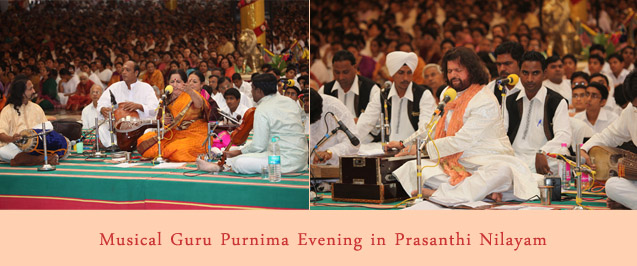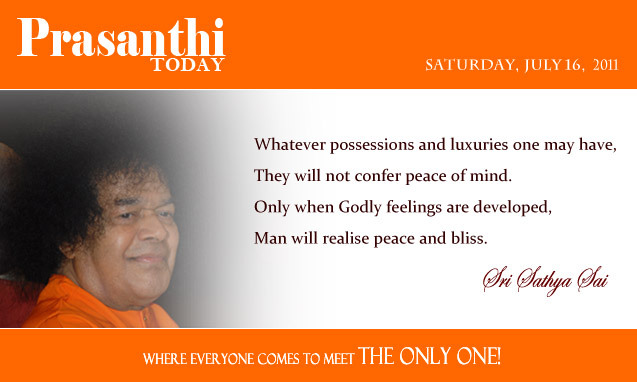|
|
General: GURU PURNIMA EN LA TARDE EN PRASHANTI NILAYAM, 15 DE JULIO 2011
Elegir otro panel de mensajes |
|
|
| De: luistovarcarrillo (Mensaje original) |
Enviado: 16/07/2011 13:58 |

Published Friday, July 16, 2011 @ 1037 Hrs. The programme for the evening started with Veda chanting at 4.30. After Veda chanting, two programmes were slated for this session. The first was by famous Carnatic classical music exponent Smt. Aruna Sairam. Aruna Sairam received vocal training from her mother Rajalakshmi Sethuraman, who was a disciple of the Alathur Brothers and Thanjavur Sankara Iyer. She later received training from prominent vocalists, Madurai Somasundaram and T. Brinda. She also learnt the art of Pallavi singing from T. R. Subramaniam. Aruna Sairam collaborated with many Indian artistes like the famous playback singer Shankar Mahadevan apart from internationally acclaimed artistes like Dominique Vellard, the French Gregorian singer. Aruna Sairam has presented her concerts in all major Sabhas in India, as well as many destinations across the world, including Carnegie Hall in New York, Le Theatre de la Ville in Paris and the Festival of World Sacred Music in Morocco. 
Aruna Sairam started her concert by paying obeisance to Guru through the Sloka (verse): Gurur-Brahma Gurur-Vishnu Gurur Devo Maheswara; Guru Sakshat Param Brahma Thasmai Sri Gurave Namaha.(Guru is Brahma, Guru is Vishnu, Guru is Maheswara. Guru is verily the supreme Brahman. So, salutations to the Guru). She was accompanied by artistes on Ghatam, Mridangam, Violon and Tanpura. Her first classical piece was Samajavaragamana…Ra Rama Intidaka…, Bho Shambho Siva Shambho Swayambho…, Manasa Sancharare…, the Marathi piece which captivated one and all Bhaktajana Vatsale… The Bhajan Govinda Bolo Gopala Bolo…, the Kannada famous song of Sage Purandaradasa Bhagyadha Lakshmi Baramma…, the popular song sung during the Mahalaya period Jago Tumi Jago… Her presentation ended with the Bhajan Antharanga Sai Anathanatha Sai… At the end of the concert, all the artistes were presented shawls. Prof. Anil Kumar while complimenting the artiste Aruna Sairam mentioned that recently the “Outlook” magazine had compared Aruna Sairam to the Queen of Music Smt. M.S. Subbulakshmi that she matched her in diction, purity, voice and impeccability. which was followed by the Thyagaraja composition The next singer for the evening was Sri Hans Raj Hans, a proponent of Sufi tradition of music. Hans Raj Hans stands tall among all Sufi singers, with his unusual ability to present this genre of music in its truest form. His voice and style of singing is indeed suited to Sufi renditions. This noted Sufi artist is a Padma Shri Awardee, the highest civilian award, presented by Hon’ble President of India Smt. Pratibha Patil for his inimitable and significant contribution in the field of music. 
His performances have not only established him as a musical treasure in his own country, India, but have gained him worldwide fame. In appreciation of his contribution to Sufiana Singing, San Jose University, California, U.S.A. had appointed him as visiting Professor of Sufism. A recipient of numerous honours from the beginning, he was awarded Punjab State Singer Award (Raj Gayak) by the Punjab Government. He has been conferred lifetime fellowship by Punjabi University, Patiala, in recognition of his originality and versatility. He has ceaselessly worked for Indo-Pak relations and Indo-American relations. He had the opportunity to sing in the Divine Presence during Bhagawan’s visit to Delhi in 2010. Sri Hans Raj Hans said, “I am fortunate to sing in front of You in Delhi, I am singing today. You are the Supreme Creator who is never born, who never dies.” His first composition was Rakhomori Rakho Rakhomori Sai Baba. The next song conveyed that all the pride and popularity he has is because of Sai. His songs were marked by lively singing with full of verve and vigour. He enlivened the stage with his swaying and taking the audience along with him in his songs. The audience too responded by clapping to the beat of the songs. After a few more songs like Baba Jagataki Vani… Sri Hans Raj Hans ended his concert. The artistes were honoured with shawls after which Bhajans were sung by the students. The students too added to the lively mood in the devotees by singing the Bhajan Subrahmanyam Subramanyam… with full gusto. Arati was offered at 7.10 pm. Darshan of Mahasamadhi continued in the evening too. It was now the turn of students from the men and women’s campuses to have Darshan of Bhagawan’s Mahasamadhi. After students and senior staff had Darshan, devotees had Darshan of the Mahasamadhi. Guru Celebrations will continue on 16th July too with a music programme by the alumni of Sri Sathya Sai Institute of Higher Learning in the morning and a Bal Vikas drama from the State of Tamil Nadu.  sourced: | | | 
Archival (2010) : Mar - Apr - May - Jun - Jul - Aug - Sep - Oct - Nov - Dec Jan 2011 - Feb 2011 - Mar 2011 - April 2011 - May 2011 - June 2011 Updated Saturday, Jul 16, 2011 1215 Hrs. IST Morning Programme: The day after Guru Purnima, the alumni of the Sri Sathya Sai Institute of Higher Learning got the opportunity to perform in the Sai Kulwant Hall. They started the programme with a beautiful aalap, "Kaise Keh Dun Ki Aap Pas Nahi Hote..." (How can I tell that you are not near me...). This was followed by a moving prayer from the alumni expressing their gratitude and seeking blessings. The first song was a number titled "Dil Ye Gungaaye" which was a song of Divine Romance describing how the Lord was the first one with whom they were in love with. The second song titled "Mann Mero Laage Na Tere Bina Re" spoke about how their minds are always circling around their Lord. The next song with an inspiring aalap was a song in Telugu titled, "Aruna Aruna". The students then raised the tempo with the popular song, "O Sai Ma". Many in the audience who were familiar with the song also joined in. Continuing with the fast pace, the students then sang a qawwali, "Tere Dar Pe Jo Bhi Aayaa...". The students concluded with a specially composed piece, "Mere Sai Mere Baba" before which the narrator described how once a boy becomes a student of Bhagawan, he never becomes an old student but always remains a 'Sai Student'. The music programme was followed by Bhajans with the male and female students alternating between them. The Bhajans began with the emotional number, "Arj Suno Mere...", followed by Guru Mahima, Hum Sab Milkar and Ragupatey Sri Ramachandra. Arati was offered at 0940hrs. 
| sourced:
| | | | | You are in Important announcements |
| | |  | |
Aum Sri Sai Ram
Press Release by Sri Sathya Sai Central Trust July 15th, 2011 GURUPURNIMA CELEBRATIONS One of the significant features of this year’s Gurupournima celebrations at Prashanti Nilayam was the unveiling of the Mahasamadhi of Bhagawan Sathya Sai Baba. The function began with Vedic chanting at 7.30 A.M. The Sai Kulwant Hall was packed to capacity, exactly as in the days when Bhagawan was physically present. At the stroke of 8 A.M, the red curtains parted, revealing Mahasamadhi, which is a green and white marble masterpiece. This will now become the beacon which will attract millions of His devotees from all over the world. The Mahasamadhi is located in the middle of the front semi-circular porch of the Mandir at the southern end of Sai Kulwanth Hall in Prasanthi Nilayam, exactly at the place where He used to sit for giving Darshan to His devotees. The main portion of the Mahasamadhi is a rectangular pure white marbled-clad edifice 9 ft long, 6 ft wide and 2 ft 2 inches high, located exactly over the final resting place of Bhagawan. This in turn is situated in the centre of a 6 inches high white marble platform, 21 ft long and 12 ft wide. Two large pillars supporting the porch roof have also been clad with white marble and tastefully decorated. The remaining floor area of the porch has also been redone in white marble. The two flanks of the porch have been remade with deep green marble with a white marble border. The unveiling of the Mahasamadhi was followed by a presentation entitled “Guruvandana” by the students of Sri Sathya Sai Institute of Higher Learning who extolled the several facets of the personality of their Guru, Bhagawan Sathya Sai Baba. This was followed by two speakers. The first speaker was Mr. Leonardo Gutter, a psychologist and a member of the Prasanthi Council from Argentina. Mr. Leonardo Gutter spoke about the four great blessings of the devotees-to be born as a human being, to be a contemporary of the Avatar, to be aware of His divinity and to be His chosen instrument. He also spoke about devotees who came to criticise Bhagawan but who went back overwhelmed by the love of the lord. Sri Nimish Pandya, the district President from Mumbai, after expressing his gratitude to Bhagawan for the manifold blessings he has conferred on him, spoke about the activities of the Sri Sathya Sai Central Trust. After the Aarthi, everyone among the assembled gathering filed past Mahasamadhi in reverence. Media Coordinator
Sri Sathya Sai Central Trust
Prasanthi Nilayam Jai Sai Ram! | | | | | | Parthi News July 2011 (Updated 16.07.2011) |
|
|
 Primer
Primer
 Anterior
Sin respuesta
Siguiente
Anterior
Sin respuesta
Siguiente
 Último
Último

|
|
|
| |
|
|
©2025 - Gabitos - Todos los derechos reservados | |
|
|

